What can you use white onions for?
Silver or white onions are softer and sweeter in flavor than regular onions. It is especially popular in European countries. There it is used to make fresh salads and onion soups. In our country, this variety has not yet managed to win the universal love of consumers and gardeners, primarily due to its short shelf life. However, in recent years, the trend has changed, and this vegetable is increasingly found on store shelves.
In this article we will talk about the benefits of white onions, their use in cooking and traditional medicine, and find out the differences from ordinary yellow onions.
The content of the article
The origin and characteristics of white onions
White onion is a perennial plant species of the genus Allium of the Alliaceae family... It practically does not occur in the wild form; it is cultivated on private farms and on an industrial scale.
Onions were cultivated about 4 thousand years ago in Asia, on the territory of modern Afghanistan and Iran. Onions were grown in ancient India, Egypt and Greece. He was prescribed medicinal and magical properties.
Reference. In ancient Rome, legionnaires put a lot of onions in their food, because they believed that it gives courage, energy and strength.
In the X-XII century. white onion was included in the daily diet of commoners in Spain, Portugal, France... On the territory of modern Russia, the product appeared in the XII-XIII centuries, it began to be added to many dishes from cereals, meat, fish and vegetables.
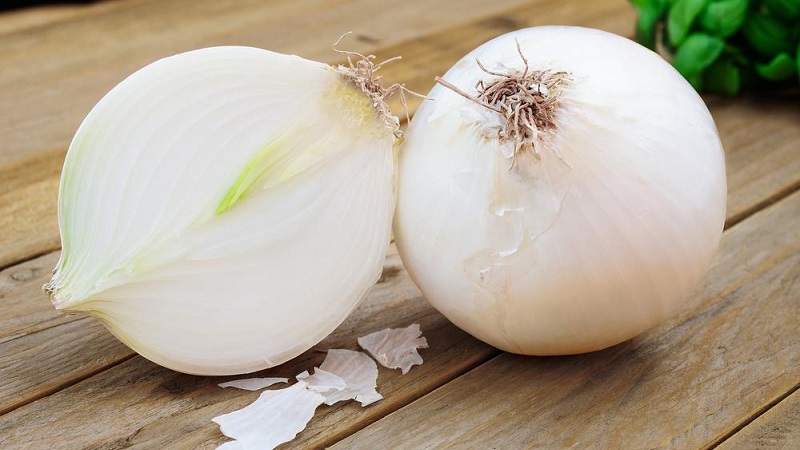
White onion bulbs are smooth and rounded... On the one hand, there is a flat bottom with roots, on the other, an elongated tail. This shape allows you to easily remove the husk by wrapping your hand around the onion.
Dry scales are almost invisible against the background of white pulp with clear greenish veins.
Sweet taste, rich aroma, pungency and pungency are weak.
The main disadvantages of this type of onion:
- low resistance to diseases and temperature extremes;
- short shelf life (3-6 months);
- exactingness to soil fertility.
Differences from other species
White bow differs from other species primarily in appearance:
- the size of the bulb is larger than the yellow one;
- the color of the husk is silvery white (in the usual onion - yellow, in the red - purple);
- the aroma is more pronounced;
- the structure is softer;
- the taste is much sweeter and more tender, without harsh bitterness.
White onions contain more iron salts, essential oils, sugars compared to regular onions. Has a shorter shelf life than red and yellow.
White onions are most often used fresh. for the preparation of vegetable salads.
Reference. The French use it to make the famous onion soup with cheese croutons.
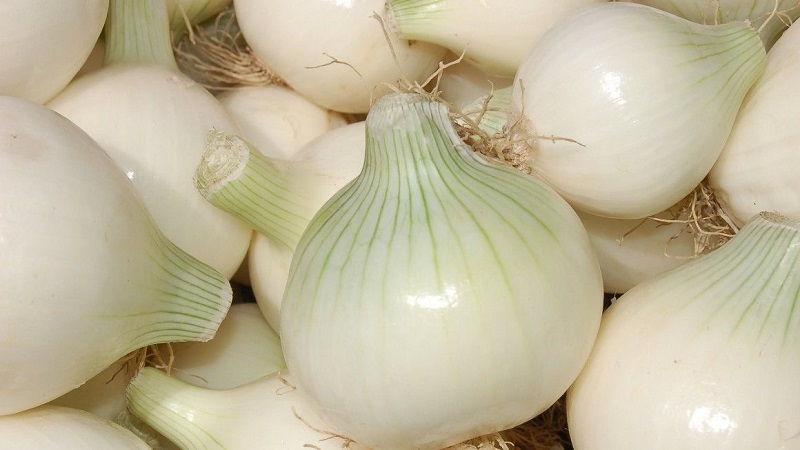
Chemical composition
The table provides a complete set of vitamins and minerals in white onions.
| Name | Content | Norm |
| Beta carotene | 0.001 mg | 5 mg |
| Vitamin B1 | 0.05 mg | 1.5 mg |
| Vitamin B2 | 0.02 mg | 1.8 mg |
| Vitamin B4 | 6.1 mg | 500 mg |
| Vitamin B5 | 0.1 mg | 5 mg |
| Vitamin B6 | 0.12 mg | 2 mg |
| Vitamin B9 | 19 μg | 400 mcg |
| Vitamin C | 7.4 mg | 90 mg |
| Vitamin E | 0.2 mg | 15 mg |
| Vitamin H | 0.9 μg | 50 mcg |
| Vitamin K | 0.4 μg | 120 mcg |
| Vitamin PP | 0.5 mg | 20 mg |
| Niacin | 0.2 mg | — |
| Potassium | 146 mg | 2500 mg |
| Calcium | 23 mg | 1000 mg |
| Silicon | 5 mg | 30 mg |
| Magnesium | 10 mg | 400 mg |
| Sodium | 4 mg | 1300 mg |
| Sulfur | 65 mg | 1000 mg |
| Phosphorus | 29 mg | 800 mg |
| Chlorine | 25 mg | 2300 mg |
| Aluminum | 400 mcg | — |
| Boron | 200 mcg | — |
| Iron | 0.21 mg | 18 mg |
| Iodine | 3 μg | 150 mcg |
| Cobalt | 5 μg | 10 mcg |
| Manganese | 0.23 mg | 2 mg |
| Copper | 39 μg | 1000 mcg |
| Nickel | 3 μg | — |
| Rubidium | 476 μg | — |
| Selenium | 0.5 μg | 55 mcg |
| Fluorine | 31 mcg | 4000 mcg |
| Chromium | 2 μg | 50 mcg |
| Zinc | 0.17 mg | 12 mg |

Essential amino acids:
- arginine;
- valine;
- histidine;
- isoleucine;
- leucine;
- lysine;
- methionine;
- methionine;
- threonine;
- tryptophan;
- phenylalanine.
Replaceable amino acids:
- alanine;
- aspartic acid;
- glycine;
- glutamic acid;
- proline;
- serine;
- tyrosine;
- cysteine.
In a white onion contains omega-3 and omega-6 polyunsaturated fatty acids.
Interesting on the site:
KBZHU
The nutritional value white onions:
- calorie content - 42.63 kcal;
- proteins - 1.1 g;
- fats - 0.1 g;
- carbohydrates - 9.34 g;
- fiber - 1.7 g;
- water - 89 g.
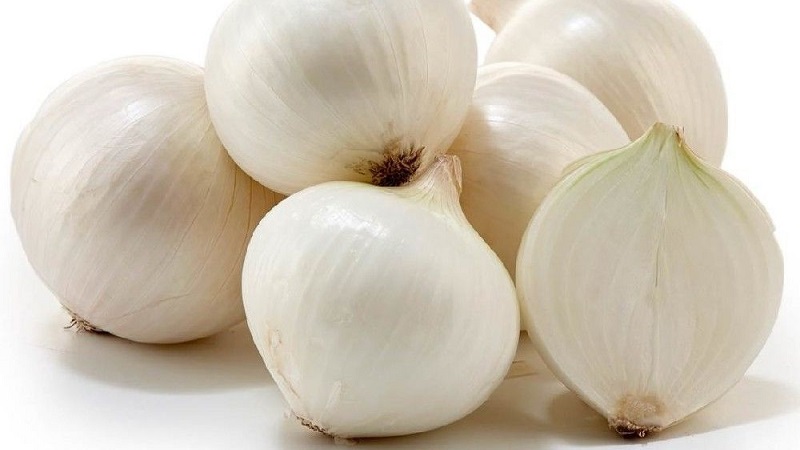
Beneficial features
The benefits of white onions for the body:
- prevention and treatment of ARVI and influenza;
- healing of abscesses and purulent wounds, burns, abscesses, boils, lichens, calluses;
- tonic, bactericidal and antioxidant effect;
- prevention of pathologies of the cardiovascular system;
- relieving itching and irritation after being bitten by mosquitoes, midges, bees, wasps, ants;
- cleansing the blood;
- normalization of bowel function;
- normalization of water-salt balance;
- regulation of the sebaceous glands;
- strengthening of hair follicles.
For women
White onions are a source of vitamin B9, which is responsible for hormones... Ascorbic acid (vitamin C) normalizes collagen synthesis, which is necessary to maintain skin elasticity, hair and nails beauty.
Regular consumption of white onions improves digestive function, speeds up metabolism, promotes weight loss.
The composition of the product helps to reduce menstrual pain, protect against breast cancer, reproductive health.
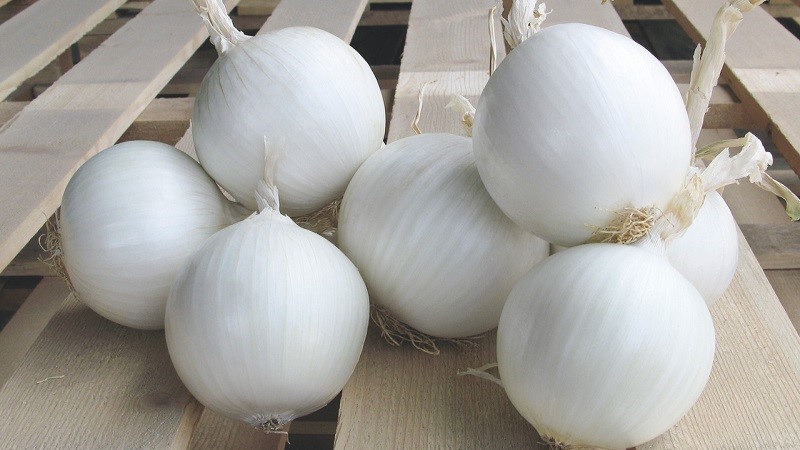
For men
White onions have a positive effect on men's health and restore reproductive function. His used to treat prostate adenoma, eliminate toxins, cleanse and strengthen blood vessels, getting rid of pain and discomfort when urinating.
The best varieties of white onions
The table shows the characteristics of the top five varieties white onions.
| Variety, hybrid | Ripening period | Bulb weight, g | Taste | Growing method | Keeping quality |
| Alba | 120-130 days | 70-80 | Semi-sharp | Seeds | 6-7 months |
| Comet F1 | 120-125 days | 50-70 | Sweet | Seeds and sevk | 6-7 months |
| Nevada | 95 days | 75-90 | Semi-sharp | Seeds | 6-7 months |
| Snowball | 100-110 days | 120-200 | Semi-sharp | Seeds and sevk | 4-5 months |
| Sterling F1 | 120-130 days | 60-200 | Semi-sharp | Seeds and sevk | 3-4 months |
Growing features
Traditionally, white onions were grown from sets and harvested in the third year of the growing season.... However, thanks to the achievements of modern breeding, varieties have appeared intended for one-year sowing through seedlings.
For cultivating white onions, a sunny area on the south side of the garden is best suited no drafts. The beds are located in the place where pumpkin, zucchini and potatoes were previously grown. The soil should be loose and nutritious. Sandy loam or loamy soils with a neutral pH (6-7) are suitable.
The beds for white onion seedlings are prepared in autumn: plowed deeply and fertilized with potassium and phosphorus. In the spring, scatter humus or wood ash and slightly loosen the ground with a rake. Furrows are formed on the site and watered abundantly with clean water.
Seedlings are planted in warm weather in the evening with an interval of 5-10 cm and a row spacing of 30 cm.
Long roots are cut in half, the feather is sheared, leaving two-thirds.
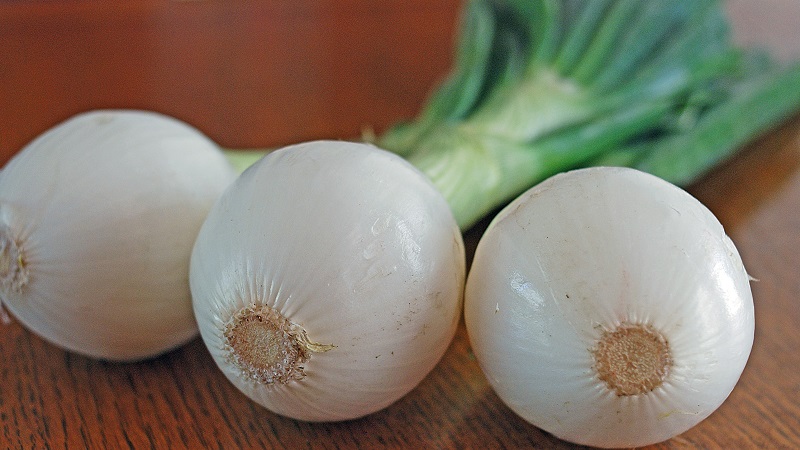
Landing dates
For full development to the stage of planting in the ground, white onion seeds need two months... Given this fact, gardeners determine the timing of sowing. The best period is the second and third ten days of February. Seedlings are planted in mid-April.
It is important not to be late with sowing, otherwise the seedlings will be weak and get sick after transplanting into open ground. This can happen even if sowing too early.
Planting white onion sets is carried out from late March to late April... The selected set is heated at a temperature of + 45 ° C for 7 hours. This prevents early ejection of the flower arrow.
Before planting, the seedlings are soaked in a 1% solution of potassium permanganate or in "Fitosporin".
Care
White onion care rules:
- weeding of weeds as they grow - at the beginning of the growing season with a narrow hoe, when the bulbs pick up their size by hand;
- loosening the earth crust after each watering for better aeration of the underground part;
- frequent and abundant watering so that the water stands during the period of feather growth, after - as the top layer of the soil dries up;
- feeding with potassium, phosphorus.
Fertilization rules:
- 14 days after planting - 25 g of urea per 10 liters of water at the root;
- 14 days after the first feeding - 25 g of superphosphate and 10 g of potassium salt per 10 liters of water at the root.
Application in traditional medicine
White onions are less commonly used in folk medicine than other varieties because of their mild action. on the body. Red onions are very active and are used to treat joints, colds, and bowel problems. Yellow onions are the hottest and healthiest. It is used in cooking and traditional medicine.
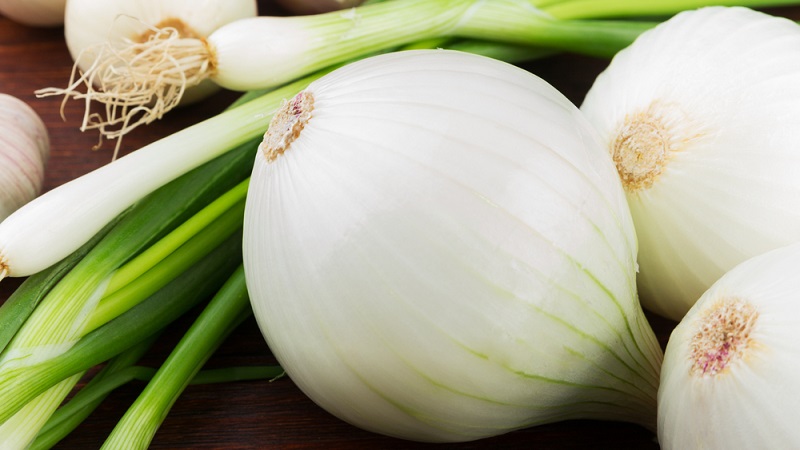
Onion tincture is used to remove worms: peel the medium onion, rub it on a fine grater, pour 200 ml of clean cold water, leave for 12 hours. The drug is taken on an empty stomach in 100 ml for 4-5 days.
To relieve edema two medium onions are finely chopped, sprinkled with 1 tsp. granulated sugar and refrigerated for 24 hours. Then squeeze the juice through cheesecloth and take it in 2 tbsp. l. three times a day 30 minutes before meals for 5 days.
To get rid of calluses and calluses, prepare a paste based on butter: a medium onion in a husk is baked in the oven, kneaded with a fork into a gruel and mixed with 1 tbsp. l. butter. The mixture is applied to the corn and covered with gauze. The tool is used until the problem is completely eliminated.
For the treatment of colds one onion is finely chopped and mixed with 2 tbsp. l. honey. The mixture is placed in the refrigerator for 3-4 hours. The released syrup is taken in 1 tbsp. l. three times a day between meals.
For the treatment of prostate adenoma, an infusion is used: 200 g of chopped onion is poured into 500 ml of dry white wine, insisted for two weeks in a dark place. Then filter the infusion and take 2 tbsp. l. three times a day, 30 minutes after meals. The course of treatment is three weeks with a break of 10 days.
To get rid of dandruff and oily seborrhea use freshly squeezed juice and brandy. The components are mixed in a 5: 1 ratio. The scalp is lubricated with a liquid, washed off after an hour. The course of treatment is for a month, twice a week.
A compress is used to treat purulent wounds: Put half the onion in a cut into a hot frying pan without oil and fry over low heat until soft. After cooling, it is applied to the sore spot and fixed with a bandage or gauze for 5 hours. Then the compress is replaced with a new one.
Read also:
Cooking applications
White onions are widely used in cooking. is he ideal for preparing fresh salads, appetizers, side dishes, stews, soups, broths, fillings.
Classic French recipe onion soup assumes the use of white onions... French chefs assure that only he gives a pleasant, rich and sweet taste to the dish. The rich aroma of the soup is based on the technology of onion preparation - sautéing. The product is stewed in oil, acquiring golden color and softness.
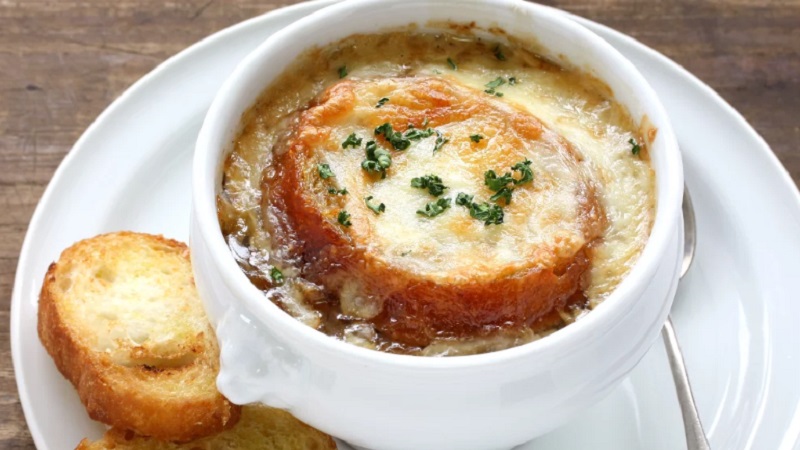
To make soup you will need such ingredients:
- white onions - 1 kg;
- butter - 60 g;
- vegetable, beef broth or boiling water - 1 liter;
- thyme - 5-7 branches;
- baguette;
- hard cheese Gruyere or Parmesan - 200 g.
Preparation:
- Peel the onion and cut into quarter or half rings.
- Melt the butter in a skillet.Put onion in it and fry over low heat, stirring occasionally until golden brown. The onions should be caramelized. Everything takes about 30 minutes.
- Pour 250 ml of broth or boiling water into the pan. Cook until the liquid has partially evaporated and add fresh thyme.
- Pour in the next portion of broth and cook until thick. Then pour in the rest of the broth, bring to a boil and cook the soup until medium thick.
- Cut the baguette into slices and dry in a dry skillet or toaster.
- Grate the cheese.
- Pour the soup into portioned fireproof bowls or pots. Sprinkle with grated cheese so that it completely covers the soup. Add a slice of baguette and sprinkle with cheese again.
- Place the containers in an oven preheated to 200 ° C and wait for the cheese to melt.
- Garnish with fresh thyme when serving.
Storage features
The safety of white onions depends on storage and harvesting conditions.... Watering is completely stopped about 30 days before harvest. Harvesting begins after the bulbs are fully ripe - the neck of the feather is dry, the feather will fall.
After harvesting, the onions are dried under a canopy with good ventilation for 10-14 days, then sorted and stacked in crates, nets, cartons, breathable bags.
The best conditions for storing onions - dry storage room with air temperature -1… + 4 ° С.
Reference. If it is not possible to create such conditions, the onions are stored in a dry room at room temperature up to + 24 ° C.
Conclusion
For 4 thousand years of cultivation and use of onions, people have managed to fully study its useful properties, find application in cooking and folk medicine. White onions are distinguished by a more delicate and sweet taste, pronounced aroma, and lack of bitterness. The product is included in various salads, soups, garnishes for meat and fish.
White onions are grown with seeds and sets. Planting care does not require much effort. It is enough to provide abundant watering at the beginning of the growing season and moderate watering after the formation of a feather, to weed and loosen, to apply mineral fertilizers.